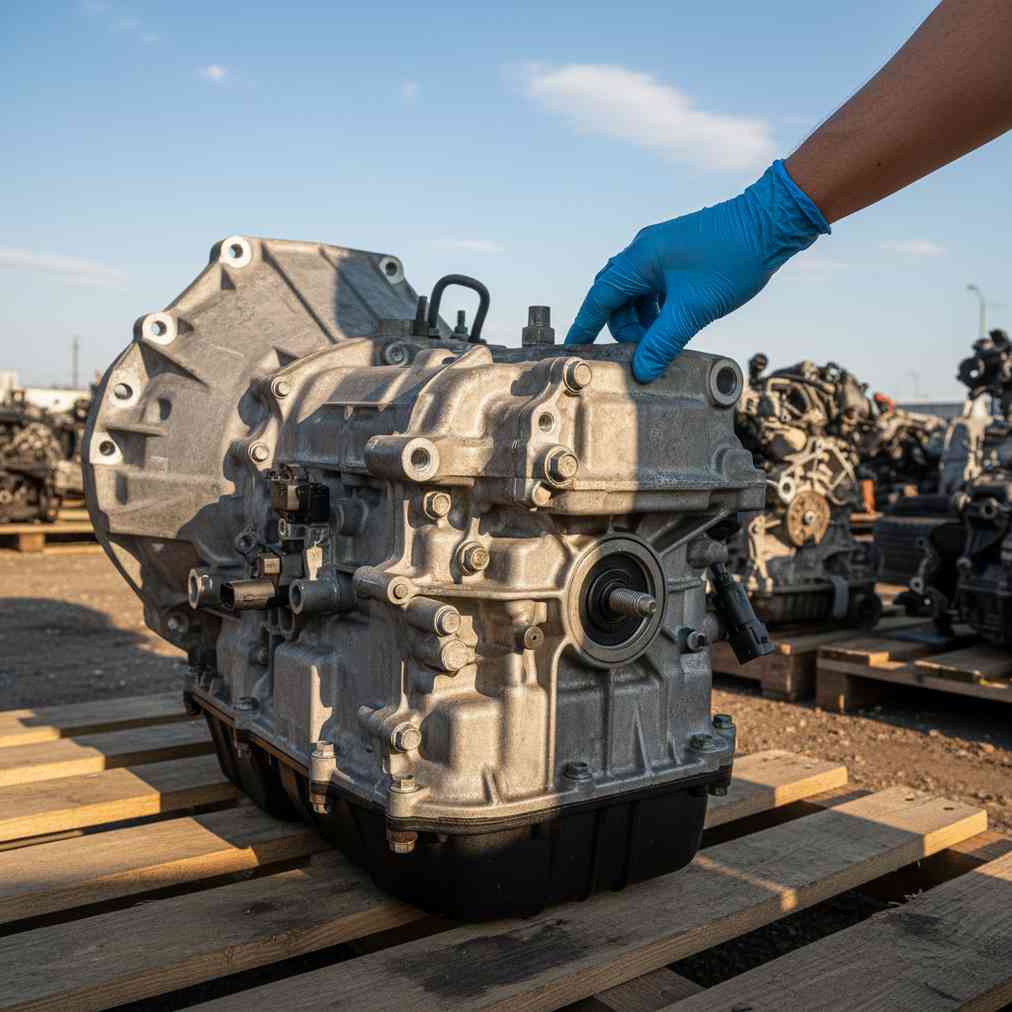Why Choose a Used Transmission from Salvage Yards?
Purchasing a used transmission from a salvage yard can offer significant savings compared to buying new or rebuilt units. However, this cost-effective approach requires careful inspection and thorough testing to avoid costly mistakes. Understanding what to look for and what to avoid can help you make an informed decision when shopping at junkyards near you.
Key Benefits of Used Transmissions
- Cost Savings: Used transmissions typically cost 50-70% less than new or rebuilt units, potentially saving thousands of dollars
- Perfect Compatibility: Parts from the same make, model, and year ensure exact fit and compatibility
- Availability: Easier to find discontinued or rare transmission models for older vehicles
- Environmental Impact: Recycled auto parts reduce waste and conserve manufacturing resources
- Quick Sourcing: Immediate availability compared to waiting for special orders
Essential Pre-Purchase Inspection Steps
Visual Inspection Checklist
The first step in evaluating any used transmission involves a comprehensive visual inspection. This initial assessment can reveal obvious problems before you invest time in more detailed testing.
| Component | What to Check | Red Flags |
|---|---|---|
| Transmission Case | Cracks, dents, rust, damage | Visible cracks, severe corrosion, impact damage |
| Mounting Points | Bolt holes, brackets, alignment | Stripped threads, broken mounts, misalignment |
| Seals & Gaskets | Leaks, wear, deterioration | Active leaks, cracked seals, wet residue |
| Electrical Connections | Corrosion, damage, completeness | Corroded pins, damaged harnesses, missing connectors |
Transmission Fluid Analysis
The condition of transmission fluid serves as one of the most reliable indicators of internal transmission health. Proper fluid analysis can reveal hidden problems that aren’t immediately visible.
- Color Assessment: Healthy fluid appears pinkish-red to light brown
- Smell Test: Fresh fluid has minimal odor; burnt smell indicates overheating
- Consistency Check: Fluid should flow smoothly without thick or gummy texture
- Contamination Detection: Look for metal shavings, debris, or foam formation
- Level Verification: Adequate fluid levels suggest proper maintenance history
“Dark, burnt-smelling transmission fluid is the single most reliable indicator of internal damage and should be treated as an immediate red flag when inspecting used transmissions.”
Mechanical Testing Procedures
Manual Operation Tests
When possible, perform hands-on mechanical testing to assess the transmission’s operational integrity. These tests can reveal internal wear and damage that visual inspection might miss.
- Input Shaft Rotation: Turn the input shaft manually to check for smooth operation
- Output Shaft Response: Verify appropriate output shaft movement with input rotation
- Gear Engagement: Test shifting through available gears for smooth engagement
- Clutch Operation: Assess clutch engagement and release (manual transmissions)
- Torque Converter Check: Inspect for damage or excessive play (automatic transmissions)
Diagnostic Testing with OBD Tools
Modern diagnostic tools can uncover hidden electronic issues that affect transmission performance. Using an OBD scanner helps identify stored error codes and system malfunctions.
| Diagnostic Area | Common Issues | Impact Assessment |
|---|---|---|
| Solenoid Function | Valve body problems, electrical faults | Shifting irregularities, performance loss |
| Sensor Readings | Speed sensors, pressure switches | Erratic shifting, warning lights |
| Control Module | Programming issues, communication errors | Complete transmission failure |
| Pressure Systems | Hydraulic leaks, pump problems | Slipping, delayed engagement |
Critical Red Flags to Avoid
Immediate Disqualifiers
Certain conditions should immediately eliminate a used transmission from consideration, regardless of price or availability. These red flags indicate fundamental problems that are unlikely to be economically repairable.
- Burnt Transmission Fluid: Dark, foul-smelling fluid indicates severe overheating damage
- Metal Contamination: Shavings or particles suggest internal component failure
- Case Damage: Cracks or structural damage compromise transmission integrity
- Excessive Leakage: Multiple leak points indicate widespread seal failure
- Grinding Noises: Internal mechanical damage requiring expensive repairs
Warning Signs Requiring Expert Assessment
Some issues may not immediately disqualify a transmission but require professional evaluation to determine repair feasibility and cost-effectiveness.
| Warning Sign | Potential Issue | Resolution Difficulty |
|---|---|---|
| Hesitant Shifting | Valve body problems, clutch wear | Moderate to High |
| Minor Fluid Leaks | Gasket replacement needed | Low to Moderate |
| Electronic Codes | Sensor or solenoid issues | Low to Moderate |
| Unusual Noises | Bearing wear, gear damage | High |
Compatibility and Documentation Verification
Ensuring Proper Fit
Transmission compatibility extends beyond basic make and model matching. Subtle variations in engine codes, transmission options, and production dates can affect proper fitment and operation.
- VIN Matching: Use vehicle identification numbers for precise compatibility confirmation
- Part Number Verification: Cross-reference manufacturer part numbers for exact matches
- Engine Code Compatibility: Ensure transmission matches specific engine configurations
- Production Date Considerations: Account for mid-year changes and updates
- Option Package Verification: Confirm transmission specifications match vehicle options
Service History and Warranty Documentation
Comprehensive documentation provides valuable insights into the transmission’s maintenance history and potential longevity. Reputable salvage yards often provide some form of quality assurance.
- Mileage Records: Lower mileage units typically offer better long-term reliability
- Maintenance History: Regular service indicates proper care and maintenance
- Previous Repairs: Understanding past issues helps predict future problems
- Donor Vehicle Condition: Accident vs. mechanical failure provides context for transmission condition
- Warranty Options: Limited warranties offer protection against immediate failures
Professional Inspection and Testing
When to Seek Expert Help
While basic inspection can be performed by most car owners, complex transmission systems often require professional assessment to identify subtle problems that could prove costly after installation.
- High-Value Purchases: Expensive transmissions justify professional inspection costs
- Complex Systems: Modern computer-controlled transmissions require specialized knowledge
- Uncertainty Factors: Unknown history or questionable condition warrant expert evaluation
- Specialized Testing: Pressure tests and electronic diagnostics require professional tools
- Installation Planning: Compatibility and modification requirements need expert assessment
Advanced Testing Procedures
Professional mechanics have access to specialized equipment and testing procedures that can reveal problems invisible to basic inspection methods.
| Test Type | Equipment Required | Issues Detected |
|---|---|---|
| Pressure Testing | Hydraulic pressure gauge | Pump efficiency, valve body problems |
| Electronic Diagnosis | Professional scan tool | Control module issues, sensor faults |
| Road Testing | Test vehicle setup | Real-world performance issues |
| Endoscopic Inspection | Boroscope camera | Internal wear, component damage |
Cost-Benefit Analysis and Decision Making
Financial Considerations
Making an informed decision about used transmission purchases requires careful analysis of total costs versus potential savings. Consider all expenses associated with the purchase and installation process.
- Purchase Price: Initial transmission cost from salvage yard
- Inspection Costs: Professional evaluation and testing fees
- Installation Expenses: Labor and additional parts for installation
- Potential Repairs: Additional work that may be discovered during installation
- Warranty Value: Protection against immediate failure costs
Risk Assessment Matrix
Evaluate the overall risk versus reward ratio when considering different used transmission options. This assessment helps guide decision-making based on individual circumstances and risk tolerance.
| Risk Level | Characteristics | Recommended Action |
|---|---|---|
| Low Risk | Low mileage, good fluid, warranty | Proceed with confidence |
| Moderate Risk | Average mileage, minor issues | Professional inspection recommended |
| High Risk | High mileage, unknown history | Consider alternatives |
| Extreme Risk | Visible damage, contaminated fluid | Avoid purchase |
Installation Preparation and Best Practices
Pre-Installation Requirements
Proper preparation before installation helps ensure successful transmission replacement and optimal performance. Planning ahead prevents delays and additional costs during the installation process.
- Fluid Requirements: Obtain correct type and quantity of transmission fluid
- Filter Replacement: Plan to replace filters and gaskets during installation
- Additional Components: Consider replacing related parts like mounts and cooler lines
- Special Tools: Ensure access to required installation tools and equipment
- Break-in Procedures: Understand proper procedures for new transmission operation
Quality Assurance Steps
Implementing quality assurance measures during and after installation helps identify potential problems early and ensures optimal transmission performance.
- Proper Torque Specifications: Follow manufacturer specifications for all connections
- Fluid Level Verification: Ensure correct fluid levels after installation
- Initial Testing: Perform careful initial operation tests
- Break-in Period Monitoring: Watch for issues during initial operation period
- Follow-up Inspection: Schedule post-installation checks for early problem detection
Final Recommendations for Used Transmission Buyers
Successfully purchasing a used transmission requires patience, thorough inspection, and realistic expectations. While significant savings are possible, buyers must balance cost considerations with quality and reliability requirements.
Before making final decisions, consider whether repairs to your existing transmission might be more cost-effective. If your current vehicle has reached the point where cash for cars options provide better value than major repairs, it may be time to explore alternative solutions.
- Research Thoroughly: Understand your specific transmission requirements before shopping
- Inspect Carefully: Never skip comprehensive visual and mechanical inspection steps
- Verify Compatibility: Confirm exact fitment before committing to purchase
- Consider Professional Help: Expert inspection often pays for itself in avoided problems
- Plan for Installation: Budget for proper installation and related components
- Maintain Realistic Expectations: Used transmissions require careful maintenance and monitoring
By following these comprehensive guidelines and maintaining realistic expectations, buyers can successfully navigate the used transmission market and achieve significant cost savings while obtaining reliable replacement components for their vehicles.





Leave a Reply
You must be logged in to post a comment.